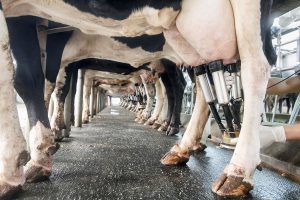A revelation and razor-sharp tool for identifying Staph aureus. That’s how Neerim South vet Dr Rob Bonanno sums up the StaphGold® ELISA test, after witnessing a surprisingly rapid high cell count recovery on a Gippsland dairy farm this season.
“If surveillance by other means suggests that a farmer has Staph aureus present in the herd, vets and farmers should consider using the StaphGold test” he says.
Bonanno, ProDairy Regional Lead at Apiam Animal Health, was brought in by local vets when a 280-cow operation failed to respond to usual interventions and took a turn for the worse – incurring a sudden 20% penalty for poor milk quality. Bonus payments reflect a large slice of projected revenue for dairy farmers and Andrew and Lynaire Goold, who own the Gippsland farm, were facing the prospect of losing significant portions of income for the rest of the lactation without an aggressive management approach.
Milk culture tests showed the presence of Staph aureus in half of Goold’s top 20% high cell count cows. Bonanno had been pondering the best next steps to take when he caught a presentation on StaphGold® at the Herd23 Conference– and thought it might be worth a crack.
The StaphGold® ELISA test, developed by Koru Diagnostics, is a highly accurate laboratory test that identifies specific biomarkers of a dairy cow’s immune response to Staph aureus bacteria. The test can pick up ‘incognito’ Staph cows, quietly existing within a farm’s low-SCC animals, shedding bacteria intermittently and spreading the infection to healthy cows.
With 30 years as a dairy veterinarian, Bonanno says using StaphGold® for the first time uncovered some big surprises. First was the close alignment of Staph aureus culture-positive high cell count animals with those identified by the StaphGold® test.
“When the culture result matched up with the StaphGold result, I knew it read well.”
The next revelation was recognising just how many Staph aureus cows were in the ‘infected’ herd. Then after running the StaphGold® test across the main herd, Bonanno was surprised to see nearly a dozen more Staph aureus-positive cows in the low cell count group that would have been potentially infecting cows in the clean herd. StaphGold® is validated to screen whole herds, rather than just high-SCC cows (>200,000 SCC/mL).
The StaphGold® test is a tool that refines the traditional ‘blunt instrument’ approach of splitting a herd by an arbitrary cell count (e.g. 250,000 SCC/mL).
“Without the StaphGold test, we wouldn’t have adequately reduced the risk in the clean herd and we would have increased the risk of exposure for the negative cows in the contagious herd.”
“For farmers”, Bonanno says “StaphGold presents a systematic approach, provides more rigour around the culling, mating and do-not-breed decisions.”
“For corporate farms with investors and where cows are an asset, it is much harder to make the decision to cull. With objective data that says ‘this is a cow that has a high cell count, she has contagious mastitis, she has carried infection from one lactation to the next so she has a very low likelihood of a cure’. You can mount that objective argument of why she should go, as compared to in the past where it would be a more subjective best-guess.”
“For vets, StaphGold is a tool. If you are culturing high-SCC cows, have identified a Staph aureus-positive herd, and they are getting an increase in new infections, chronic cows that are not curing during dry-off periods, here’s a tool to identify those animals and eliminate them from the herd – or at least minimise the risk they pose from other cows by milking them last or milking them separately.”
Alison Digney, Business Development Manager for Koru Diagnostics and disease management specialist, says a flash rise in cell count can indicate active spreading of the infection.
“When people have an underlying issue with Staph aureus that they are unaware of, as soon as a stressor event occurs, like the Victorian floods last year, there is a lot more rapid spreading of the infection. You start to see cell counts rise exponentially – and people are shocked by the level of infection on their farm. They might think that they have a couple of cases of subclinical, but it turns out to be one-third or half their herd. It blows their mind, but it shows they may have had an underlying problem for a long time.”
We have seen this a lot. People do spot testing, then test with StaphGold – and wow! When they realise the severity of the problem, it changes how they approach management of Staph aureus.”
Rhys McKinlay, CEO of Koru Diagnostics says StaphGold® is also used in whole herd screening at the end of a lactation to help make selective dry cow therapy decisions, then early in the next lactation to determine milking order, and to find chronically infected cows that haven’t responded to therapy.
More detailed information on Andrew and Lynaire Goold’s Staph aureus challenge and resolution can be found here – https://www.korudiagnostics.com/staphgold-australia-casestudies-gippslandscc/


